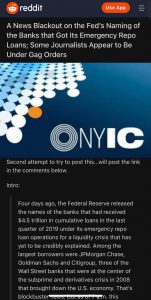Tue Jan 4 05:40:49 2022
(*6952cd93*):: +public!
(*18487022*)::

(*18487022*):: Article text ARTICLE TEXT: Four days ago, the Federal Reserve released the names of the banks that had received $4.5 trillion in cumulative loans in the last quarter of 2019 under its emergency repo loan operations for a liquidity crisis that has yet to be credibly explained. Among the largest borrowers were JPMorgan Chase, Goldman Sachs and Citigroup, three of the Wall Street banks that were at the center of the subprime and derivatives crisis in 2008 that brought down the U.S. economy. That’s blockbuster news. But as of 7 a.m. this morning, not one major business media outlet has reported the details of the Fed’s big reveal.
On September 17, 2019, the Fed began making trillions of dollars a month in emergency repo loans to 24 trading houses on Wall Street. The Fed released on a daily basis the dollar amounts it was loaning, but withheld the names of the specific banks and how much they had borrowed. This made it impossible for the public to see which Wall Street firms were experiencing the most severe credit crisis.
It was the first time the Fed had intervened in the repo market since the 2008 financial crash – the worst financial crisis since the Great Depression. The COVID-19 crisis remained months away. The first reported case of COVID-19 in the U.S. was not reported by the CDC until January 20, 2020 and the World Health Organization did not declare a pandemic until March 11, 2020.
The dollar amounts of the Fed’s repo loans grew to staggering levels. On October 24, 2019, we reported the following:
”The New York Fed will now be lavishing up to $120 billion a day in cheap overnight loans to Wall Street securities trading firms, a daily increase of $45 billion from its previously announced $75 billion a day. In addition, it is increasing its 14-day term loans to Wall Street, a program which also came out of the blue in September, to $45 billion. Those term loans since September have been occurring twice a week, meaning another $90 billion a week will be offered, bringing the total weekly offering to an astounding $690 billion. It should be noted that if the same Wall Street firms are getting these loans continuously rolled over, they are effectively permanent loans. (That’s exactly what happened during the 2007-2010 Wall Street collapse: some teetering Wall Street casinos received, individually, $2 trillion in cumulative loans that were rolled over for two and one-half years – without the authorization or even awareness of Congress or the American people. One bank, Citigroup, received over $2.5 trillion in Fed loans, much of them at an interest rate below 1 percent, at a time when it was insolvent and couldn’t have obtained loans in the open market at even high double-digit interest rates.)”
Under the Dodd-Frank financial reform legislation of 2010, the Fed was legally required to release the names of the banks and the amounts they borrowed “on the last day of the eighth calendar quarter following the calendar quarter in which the covered transaction was conducted.” The New York Fed released the information for the third quarter of 2019 last Thursday, a day earlier than required. We reported on it the following day.
Those Fed revelations, that had been withheld from the American people for two years, should have made front page headlines in newspapers and on the digital front pages of every major business news outlet. Instead, there was a universal news blackout of the story at the largest business news outlets, including: Bloomberg News, the Wall Street Journal, the business section of the New York Times, the Financial Times, Dow Jones’ MarketWatch, and Reuters.
Could this critically important story have simply slipped by all of the dozens of investigative reporters and Fed watchers at these news outlets? Absolutely not. The Fed was required to release its repo loan data and names of the banks for the span of September 17 through September 30, 2019 at the end of the third quarter of this year. We reported on what that information revealed on October 13. Because we were similarly stunned by the news blackout on that Fed release, out of courtesy we sent our story to the reporters covering the Fed for the major news outlets. Our article alerted each of these reporters that a much larger data release from the Fed, for the full fourth quarter of 2019, would be released on or about December 31. The data was posted at the New York Fed sometime before 1:23 p.m. ET last Thursday.
A The most puzzling part of this news blackout is that the majority of the reporters who covered this Fed story at the time it was happening in 2019, are still employed at the same news outlets. We emailed a number of them and asked why they were not covering this important story. Silence prevailed. We then emailed the media relations contacts for the Wall Street Journal, the New York Times, the Financial Times and the Washington Post, inquiring as to why there was a news blackout on this story. Again, silence.
Next, we emailed a number of reporters who had covered this story in 2019 but were no longer employed at a major news outlet. We asked their opinion on what could explain this bizarre news blackout on such a major financial story. We received emails praising our reporting but advising that they “can’t comment.”
The phrase “can’t comment” as opposed to “don’t wish to comment” raised a major alarm bell. Wall Street megabanks are notorious for demanding that their staff sign non-disclosure agreements and non-disparagement agreements in order to get severance pay and other benefits when they are terminated. Are the newsrooms covering Wall Street megabanks now demanding similar gag orders from journalists? If they are, we’re looking at a form of corporate tyranny previously unseen in America.
(*6952cd93*):: .